Urban and Extra-Urban Hybrid Vehicles: A Technological Review
Abstract
1. Introduction
- It is dangerous. In 2014, the World Health Organization (WHO) defined transport as “a first class medical drama” that causes over 3000 deaths per day and affects 90% of the world’s poorest countries (those with a lower degree of motorized transport);
- Motorized transport excludes other modes of transport. It has difficulties tolerating pedestrians, cyclists, and public transport and forces them to protect themselves (construction of sidewalks, bike paths, green areas) or to retreat underground (subway).
- Motorized transport model space in favor of sparsely populated cities is very scattered. The most obvious example is that of West Coast American cities (with a population density lower than 25 people per hectare and a consumption for transport which is more than 1.5 toe/inhabitant). On the other extreme are Asian cities, exemplified by Hong Kong (with a density of almost 350 inhabitants per hectare and a consumption of 0.1 toe/inhabitant).
- Transport 36% (2/3 due to wheeled transportation);
- Industry 26%;
- Civil industry 17%;
- Agriculture 11%.
- Transport inefficiencies costing, globally, between 1 and 2 trillion $ per year;
- That congestion is responsible for, approximately, 1% (100 billion) of GDP in developed economies.
2. Electric Vehicles (EVs) & Hybrid Vehicles (HVs) Definition
2.1. Briefly Electric Vehicle Description
2.2. Hybrid Vehicles
- 1
- Series
- 2
- Parallel
- 3
- Combined
2.2.1. Series Hybrid
- (a)
- Generate the electricity to power the electric motor;
- (b)
- Recharge the batteries.
2.2.2. Parallel Hybrid
2.2.3. Combined Hybrid
2.2.4. Hybrid Electric Vehicles: Passenger Sedans, Sports Cars, City Cars
2.2.5. Electric/Hybrid Buses in the Public Transport
2.2.6. Other Hybrid Electric Vehicles
2.3. Degree of Hybridization
3. Hybrid Vehicles: Operative Description
- A small heat engine that delivers a small power with low pollutant emissions, but delivers very uninteresting performance during extra-urban missions.
- A larger internal combustion engine suitable for extra-urban and highway missions, but certainly not economically advantageous in urban cycles, with high consumption and emissions.
3.1. HV Powertrain Control and Management
- Fuel consumption minimization;
- Fuel economy;
- Emissions minimization;
- Good drivability;
- Minimum system cost.
3.2. Energy Management
- Rule-Based (RB)
- Optimization-Based (OB)
3.3. The Rule-Based Control Strategy
3.3.1. Deterministic Approach
3.3.2. Fuzzy Rule Method
- Robustness: the logic is tolerant of imprecise measurements and component variation
- Adaptation: since the fuzzy rules can be easily adjusted [53]
3.3.3. Optimization-Based Control Strategy
3.3.4. Global Optimization
3.3.5. Real Time Optimization
3.4. Controller Units
3.5. Regenerative Braking Control Strategy
4. System Components
4.1. Battery Packages
- By the thermal engine;
- By a plug-in charging station;
- By KERS.
- The battery cell voltage:E = 3.2 + 0.3 SOC in chargingE = 3.2 + 0.3 SOC in charging
- Maximum current for battery package fast charging:(the manufacturers propose operating with a current equal to the battery capacity (C)).Imax,in = C1 (1 − SOC)
- Battery power.with:PBP,max,in = V·Imax,inso:V = ncell (3.2 + 0.3 SOC)PBP,max,in = ncell (3.2 + 0.3 SOC) C1 (1 − SOC)
4.2. Ultracapacitors
- High/low temperature utilization
- Long life
- Low weight
- PB free/ecofriendly
- Low recharge times
- Endless number of cycles
- Limited overall dimensions
4.3. Flywheels
- Adjusting the output power (as in ICEs)
- Accumulate energy
- Delivering energy (in the HV the braking energy can be collected by a flywheel, which uses it to recharge the battery package)
4.4. Fuel Cells
4.5. Electric Motors
- high torque for starting operation;
- low speed hill climbing operation;
- high power density for acceleration;
- high speed cruising for highway;
- high efficiency over wide torque and speed range;
- suitability for regenerative braking;
- over load capability during certain period of time;
- controllability;
- high reliability;
- robustness;
- affordable costs;
- fault tolerant capability;
- minimum torque ripple;
- temperature management;
- low acoustic noise.
4.5.1. DC Motors
4.5.2. Induction Motors
- simplicity;
- high reliability;
- robustness;
- wide speed range;
- low maintenance;
- low torque ripple/noise;
- low cost;
- established power electronic converters;
- the ability to operate in hostile environments.
- high losses;
- poor power factor;
- low efficiency;
- low inverter usage;
- greater weight and volume.
4.5.3. Permanent Magnet Motors
- highly efficient operation;
- compact packaging;
- reliability;
- maintenance free operation;
- effective heat dissipation.
- torque density;
- flux weakening capability;
- over load capability;
- stator iron losses;
- rotor eddy current losses;
- demagnetization withstanding capability.
- overall operational efficiency
- wide speed,
- constant power operation.
4.5.4. Switched Reluctance Motors
- no magnet rotor
- robust construction
- excellent torque–speed characteristics
- fault tolerant capability,
- constant power region can be extended up to 3–7 times,
- smooth operation mode
- hazard free operation.
- high acoustic noise,
- vibrations,
- high torque ripple,
- complex control mechanism
- requirement of special converter topology.
4.6. Thermal Engines
4.6.1. ICE Engines
4.6.2. GT Devices
- Specific consumption (Off-Design) [kg/kWh]:
- Instant ct consumption [kg/s]:
- Total consumption [kg/mission]:or in discrete form:
- Total consumption [kg/km]:
- Total consumption [km/L]:
- Total specific consumption [g/kWh]:with = total energy needed to complete the mission
5. Selection of the Optimal Configuration
5.1. Simulation Details
5.2. Driving Cycles and Vehicle Characteristics
5.3. Simulations Results
5.4. Component Packaging
6. Final Remarks and Future Trends
- Advantages
- Minimization of fuel consumption: thanks to its structure, in pure electro-traction mode the HV can be considered a “zero emission vehicle”. In the hybrid operation (both series and parallel) it significantly reduces the energy and fuel consumption.
- Financial benefits: Actually, in some countries, many incentives are promoted for the purchase of an EHV.
- KERS regenerative braking system: during vehicle braking, the KERS device helps to recharge the battery. An internal mechanism is capable of capturing the released energy and uses it to charge the battery. A significant aspect is the reduction of recharging time.
- Lighter materials: hybrid electric vehicles are made of lighter materials that means lower required energy. The engine/motor is also smaller, lighter, and cheaper.
- Drawbacks
- Lower Power: In the HV two engines are considered, and depending on the configuration, the thermal engine (which can be the prime mover in parallel hybrids or a range extender in series ones) is smaller than standard commercial ones. Sometimes, for the “city/urban driving”, the combined power available is lower than that of a commercial vehicle.
- Cost: at present, HVs cost is up to 15,000/18,000 €, more than a standard commercial version. However, in time that extra amount can be reduced with lower running cost and restrictions.
- Higher Maintenance Costs: the components used are high tech devices, consequently, expert and skilled “mechanics” and dedicated spare parts are required.
- Safety Issues: In case of a crash, the high voltage present inside the batteries can be dangerous or even lethal for the driver (as F1 driver Alonso can confirm).
- Assisting batteries during transient hard states;
- Increasing battery life;
- Decreasing the size of the battery packs;
- Offering performance independent of battery status;
- Increasing the power availability, and, consequently, the autonomy of the vehicle;
- Improving the energy efficiency through regenerative braking.
7. Conclusions
Funding
Conflicts of Interest
Nomenclature
| AC | Alternate Current |
| AFC | Alkaline Fuel Cell |
| b | Vehicle width |
| BMU | Battery Management Unit |
| BP | Battery package |
| cx | Drag coefficient |
| C | Coefficient |
| C | Torque [N∙m] |
| DC | Direct Current |
| DSCU | Drive System Control Unit |
| DTC | Drive Torque Control |
| EBSCU | Electronic Braking System Control Unit |
| E | Energy [J] |
| ECE | European Cycle Evaluation |
| EDLC | Electrostatic Double Layer Capacitor |
| EM | Electric Motor |
| EMR | Energetic Macroscopic Representative |
| EUDC | Extra Urban Drive Cycle |
| EV | Electric Vehicle |
| EVCU | Electric Vehicle Control Unit |
| FCEV | Fuel Cell Electric Vehicle |
| FCV | Fuel Cell Vehicle |
| FOC | Field Orientated Control |
| GT | Gas Turbine set |
| GTHV | Gas Turbine Hybrid Vehicle |
| H | Vehicle height |
| HD | Hybridization Degree |
| HEV | Hybrid Electric Vehicle |
| HPP | Hybrid power pack |
| HV | Hybrid vehicle |
| ICE | Internal Combustion Engine |
| ISG | Integrated Starter Generator |
| KERS | Kinetic Energy Recover System |
| LHV | Low Heating Value [J/kg] |
| m | Mass [kg/s] |
| MCFC | Molten Carbonate Fuel Cell |
| MTBF | Mean Time Before Failure |
| OB | Optimization Based |
| P | Power [W] |
| Pb | Lead |
| PAFC | Phosphoric Acid Fuel Cell |
| PEM | Proton Exchange Membrane |
| PEMFC | Proton Exchange Membrane Fuel Cell |
| PHEB | Plug-in Hybrid Electric Boat |
| PHEV | Plug-in Hybrid Electric Vehicle |
| PM | Permanent Magnet |
| r | Radius [m] |
| R | Resistance |
| RB | Rule Based |
| R&D | Research and Development |
| SAPHT | Solar Assist Plug-in Hybrid Electric Tractor |
| SOC | State of Charge |
| SOFC | Solid Oxide Fuel Cell |
| T | Temperature [K] |
| UCU | Ultra capacitor Control Unit |
| UDDS | Urban Dynamometer Driving Schedule |
| V | Voltage [V] |
| VCU | Vehicle Control Unit |
| VMU | Vehicle Management Unit |
| WVU | West Virginia University |
| ZEV | Zero emission Electric Vehicle |
| Subscripts | |
| GT | Gas Turbine |
| nom | nominal |
| Greek Symbol | |
| α | area ratio |
| δ | density [kg/m3] |
| ω | angular velocity [rad/s] |
References
- EPA United States Environmental Protection Agency. Available online: https://www.epa.gov/ghgemissions/sources-greenhouse-gas-emissions (accessed on 5 June 2018).
- Banjac, T.; Trenc, F.; Katrasnik, T. Energy conversion efficiency of hybrid electric heavy-duty vehicles operating according to diverse drive cycles. Energy Convers. Manag. 2009, 50, 2865–2878. [Google Scholar] [CrossRef]
- Bradley, T.H.; Frank, A.A. Design, demonstrations and sustainability impact assessments for plug-in hybrid electric vehicles. Renew. Sustain. Rev. 2009, 13, 115–128. [Google Scholar] [CrossRef]
- Capata, R.; Coccia, A.; Lora, M. A proposal for the CO2 abatement in urban areas: The UDR1–Lethe© turbo-hybrid vehicle. Energies 2011, 4, 368–388. [Google Scholar] [CrossRef]
- Bayindir, K.C.; Gözüküçük, M.A.; Teke, A. A comprehensive overview of hybrid electric vehicle: Powertrain configurations, powertrain control techniques and electronic control units. Energy Convers. Manag. 2011, 52, 1305–1313. [Google Scholar] [CrossRef]
- Chan, C.C. The state of the art of electric, hybrid and fuel cell vehicles. Proc. IEEE 2007, 95, 704–718. [Google Scholar] [CrossRef]
- Offer, G.J.; Howey, D.; Contestabile, M.; Clague, R.; Brandon, N.P. Comparative analysis of battery electric, hydrogen fuel cell and hybrid vehicles in a future sustainable road transport system. Energy Policy 2010, 38, 24–29. [Google Scholar] [CrossRef]
- Amjad, S.; Neelakrishnan, S.; Rudramoorthy, R. Review of Design Considerations and Technological Challenges for Successful Development and Deployment of Plug-In Hybrid Electric Vehicles. Renew. Sustain. Rev. 2010, 14, 1104–1110. [Google Scholar] [CrossRef]
- Capata, R.; Sciubba, E. The LETHE (Low Emissions Turbo-Hybrid Engine) city car of the University of Roma 1: Final proposed configuration. Energy 2013, 58, 178–184. [Google Scholar] [CrossRef]
- Capata, R.; Sciubba, E. The Low Emission Turbogas Hybrid Vehicle Concept—Preliminary Simulation and Vehicle Packaging. J. Energy Resour. Technol. 2013, 135, 032203. [Google Scholar] [CrossRef]
- Tribioli, L.; Barbieri, M.; Capata, R.; Sciubba, E.; Jannelli, E.; Bella, G. A real time energy management strategy for plug-in hybrid electric vehicles based on optimal control theory. Energy Procedia 2014, 45, 949–958. [Google Scholar] [CrossRef]
- Cignini, F.; De Domenico, S.; Martellucci, L.; Capata, R. Hybrid Power Pack: Hybrid Powertrain for City Cars. J. Transp. Technol. 2014, 4, 315–326. [Google Scholar] [CrossRef]
- Kima, M.; Junga, D.; Mina, K. Hybrid thermostat strategy for enhancing fuel economy of series hybrid intra-city bus. IEEE Trans. Veh. Technol. 2013, 63, 3569–3579. [Google Scholar] [CrossRef]
- Momoh, O.D.; Omoigui, M.O. An Overview of Hybrid Electric Vehicle Technology. In Proceedings of the 5th IEEE Vehicle Power and Propulsion Conference, Dearborn, MI, USA, 7–11 September 2009; pp. 1286–1292. [Google Scholar]
- Yimin, G.; Ehsani, M.; Miller, J.M. Hybrid electric vehicle: Overview and state of the art industrial electronics. In Proceedings of the IEEE International Symposium on Industrial Electronics (ISIE 2005), Dubrovnik, Croatia, 20–23 June 2005; pp. 307–316. [Google Scholar]
- Voelcker, J. Toyota Racks up 7 Million Hybrids Sold Since 1997; Green Car Reports: Menlo Park, CA, USA, October 2014. [Google Scholar]
- Shah, Y.T. Energy and Fuel Integrations System. Available online: https://books.google.it/books?id=wHWmCwAAQBAJ&printsec=frontcover&dq=energy+and+fuel+integrations+system.&hl=it&sa=X&ved=0ahUKEwitrva_o5LeAhUElIsKHVTUDAcQ6AEIKjAA#v=onepage&q=energy%20and%20fuel%20integrations%20system.&f=false (accessed on 5 June 2018).
- Capata, R. Implementing a Hybrid Series Bus with Gas Turbine Device—A Preliminary Study. Int. J. Adv. Eng. Res. Sci. 2016, 3, 135–143. [Google Scholar]
- Green Car Congress 2009. Available online: http://www.greencarcongress.com/2009/10/fords-us-hybrid-sales-up-73-for-first-9-months-of-2009-total-us-hybrid-sales-down-14-for-same-period.html (accessed on 5 June 2018).
- Zou, Y.; Li, D.; Hu, X. Optimal sizing and control strategy design for heavy hybrid electric truck. Math. Probl. Eng. 2012, 2012. [Google Scholar] [CrossRef]
- Wang, C.; Shen, T.; Ji, H.; Hikiri, K. Braking torque control for parallel hybrid electric truck. Int. J. Powertrains 2014, 3, 173–196. [Google Scholar] [CrossRef]
- Hou, S.J.; Zou, Y.; Chen, R. Feed-forward model development of a hybrid electric truck for power management studies. In Proceedings of the 2nd International Conference on Intelligent Control and Information Processing, Harbin, China, 25–28 July 2011. [Google Scholar]
- Galvagno, E.; Velardocchia, M.; Vigliani, A. Drivability enhancement and transient emission reduction for a mild hybrid diesel-electric truck. Int. J. Powertrains 2013, 2, 262–291. [Google Scholar] [CrossRef]
- Lin, C.C.; Filipi, Z.; Louca, L.; Peng, H.; Assanis, D.; Stein, J. Modelling and control of a medium-duty hybrid electric truck. Int. J. Heavy Veh. Syst. 2004, 11, 349–371. [Google Scholar] [CrossRef]
- Pham, T.H.; Kessels, J.T.B.A.; Van den Bosch, P.P.J.; Huisman, R.G.M.; Nevels, R.M.P.A. On-line energy and battery thermal management for hybrid electric heavy-duty truck. In Proceedings of the American Control Conference (ACC 2013), Washington, DC, USA, 17–19 June 2013. [Google Scholar]
- Capata, R.; Sciubba, E. An Innovative Solution for Suburban Railroad Transportation: The Gas Turbine-Hybrid Train. Int. J. Thermodyn. 2005, 8, 55–66. [Google Scholar]
- Miller, A.R.; Hess, K.S.; Barness, D.L.; Erickson, T.L. System design of a large fuel cell hybride locomotive. J. Power Sources 2007, 173, 935–942. [Google Scholar] [CrossRef]
- Miller, A.R.; Peters, J.; Smith, B.E.; Velev, O.A. Analysis of fuel hybrid locomotives. J. Power Sources 2006, 157, 855–861. [Google Scholar] [CrossRef]
- Akli, C.R.; Sareni, B.; Roboam, X.; Jeunesse, A. Integrated optimal design of a hubrid locomotive with multiobjective genetic algorithms. Int. J. Appl. Electromagn. Mech. 2009, 30, 151–162. [Google Scholar]
- Jaafar, A.; Akli, C.R.; Sareni, B.; Roboam, X.; Jeuesse, A. Sizing and energy management of a hybrid locomotive based on flywheel and accumulators. IEEE Trans. Veh. Technol. 2009, 58, 3947–3957. [Google Scholar] [CrossRef]
- Planes, E.B.; Roy, N.L.; Mosquera, J.; Orti, F.; Oliver, J.A. Power balance of a hybrid power source in a power plant for a small propulsion aircraft. IEEE Trans. Power Electron. 2009, 24, 2856–2866. [Google Scholar] [CrossRef]
- Zhang, H.; Saudemont, C.; Robyns, B.M.; Petit, M. Comparison of technical features between a more electric aircraft and a hybrid electric vehicle. In Proceedings of the IEEE Vehicle Power and Propulsion Conference (VPPC 2008), Harbin, China, 3–5 September 2008. [Google Scholar]
- Capata, R.; Marino, L.; Sciubba, E. A hybrid propulsion system for a high-endurance UAV: Configuration selection, aerodynamic study, and gas turbine bench tests. J. Unmanned Veh. Syst. 2014, 2, 16–35. [Google Scholar] [CrossRef]
- Pizzo, A.D.; Polito, R.M.; Rizzo, R.; Tricoli, P. Design criteria of onboard propulsion for hybrid electric boats. In Proceedings of the International Conference on Electrical Machines (ICEM 2010), Rome, Italy, 6–8 September 2010. [Google Scholar]
- Minami, S.; Toki, T.; Yoshikawa, N.; Hanada, T.; Ashida, M.; Kitada, S.I.; Tsukuda, K. A newly developed plug-in hybrid electric boat. J. Asian Electr. Veh. 2010, 8, 1385–1392. [Google Scholar] [CrossRef]
- Bienaime, D.; Devillers, N.; Pera, M.C.; Gustin, F.; Berthon, A.; Hopdjanian, M.L. Energetic macroscopic representation of an electric network embedded in a helicopter. In Proceedings of the 2011 IEEE Vehicle Power and Propulsion Conference, Chicago, IL, USA, 6–9 September 2011. [Google Scholar]
- Tang, C.C.; Jwo, W.S. An assist-mode hybrid electric motorcycle. J. Power Sources 2007, 174, 61–68. [Google Scholar] [CrossRef]
- Andorinha, N.; Sousa, S.; Antunes, V. A new control method of an electric scooter with a hybrid ultracapacitor/battery energy storage topology. In Proceedings of the 2nd Experiment@ International Conference, Coimbra, Portugal, 18–20 September 2013. [Google Scholar]
- Ceraolo, M.; Caleo, A.; Capozzella, P.; Marcacci, M.; Carmignani, L.; Pallottini, A. A parallel-hybrid drive-train for propulsion of a small scooter. IEEE Trans. Power Electron. 2006, 21, 768–778. [Google Scholar] [CrossRef]
- Haoming, Z.; Yinghai, W. Application of synergic electric power supply in hybrid electric scooter. In Proceedings of the 32nd Chinese Control Conference, Xi’an, China, 26–28 July 2013; pp. 5672–5675. [Google Scholar]
- Dyer, J.A.; Desjardins, R.L. Carbon dioxide emissions associated with the manufacturing of tractors and farm machinery in Canada. Biosyst. Eng. 2006, 93, 107–118. [Google Scholar] [CrossRef]
- Mousazadeh, H.; Keyhani, A.; Javadi, A.; Molbi, H.; Abrinia, K.; Sharifi, A. Life-cycle assessment of a solar assist plug-in hybrid electric tractor in comparison with a conventional tractor. Energy Convers. Manag. 2011, 52, 1700–1710. [Google Scholar] [CrossRef]
- Boulon, L.; Bouscayrol, A.; Hissel, D. Inversion-based control of a highly redundant military HEV. IEEE Trans. Veh. Technol. 2013, 62, 500–510. [Google Scholar] [CrossRef]
- Kebriaei, M.; HalvaeiNiasar, A.; Asaei, B. Hybrid Electric Vehicles: An Overview. In Proceedings of the International Conference on Connected Vehicles and Expo (ICCVE 2015), Shenzhen, China, 19–23 October 2015; pp. 299–305. [Google Scholar]
- Chen, Z.; Mi, C.C.; Xiong, R.; Xu, J.; You, C. Energy management of a power-split plug-in hybrid electric vehicle based on genetic algorithm and quadratic programming. J. Power Sources 2014, 248, 416–426. [Google Scholar] [CrossRef]
- Zhou, W.; Zhang, C.; Li, J. Analysis of optimal power management strategy for series plug-in hybrid electric vehicles via dynamic programming. In Proceedings of the 2014 IEEE Conference and Expo Transportation Electrification Asia-Pacific (ITEC Asia-Pacific), Beijing, China, 31 August–3 September 2014. [Google Scholar]
- Clean Cities. Hybrid and Plug-in Electric Vehicles. Available online: https://www.afdc.energy.gov/uploads/publication/hybrid_plugin_ev.pdf (accessed on 8 June 2018).
- Capata, R.; Lora, M. The LETHE Gas Turbine Hybrid Prototype Vehicle of the University of Roma 1: Drive Cycle Analysis of Model Vehicle Management Unit. J. Energy Resour. Technol. 2007, 129, 107–116. [Google Scholar] [CrossRef]
- Shen, C.; Shan, P.; Gao, T. A Comprehensive Overview of Hybrid Electric Vehicles. Int. J. Veh. Technol. 2011, 2011. [Google Scholar] [CrossRef]
- Pisu, P.; Rizzoni, G. A comparative study of supervisory control strategies for hybrid electric vehicles. IEEE Trans. Control Syst. Technol. 2007, 15, 506–518. [Google Scholar] [CrossRef]
- Available online: https://www.pi-innovo.com/product/hybrid-and-electric-vehicle-control-strategies/ (accessed on 12 March 2018).
- Katsargyri, G.E.; Kolmanovsky, I.V.; Michelini, J.; Kuang, M.L.; Phillips, A.M.; Rinehart, M.; Dahleh, M.A. Optimally controlling hybrid electric vehicles using path forecasting. In Proceedings of the 2009 American Control Conference, St. Louis, MO, USA, 10–12 June 2009; pp. 4613–4617. [Google Scholar]
- Salmasi, F.R. Control strategies for hybrid electric vehicles: Evolution, classification, comparison and future trends vehicular technology. IEEE Trans. Veh. Technol. 2007, 56, 2393–2404. [Google Scholar] [CrossRef]
- Lee, H.D.; Sul, S.K. Fuzzy-logic-based torque control strategy for parallel-type hybrid electric vehicle. IEEE Trans. Ind. Electron. 1998, 45, 625–632. [Google Scholar]
- Rajagopalan, A.; Washington, G.; Rizzoni, G.; Guezennec, Y. Development of Fuzzy Logic Control and Advanced Emissions Modeling for Parallel Hybrid Vehicles; NREL report SR-540-32919; National Renewable Energy Laboratory: Golden, CO, USA, 2003.
- Sadegh, N.; Khan, B.; Meisel, J. Optimization of the fuel consumption of a parallel hybrid electric vehicle, advanced intelligent mechatronics. In Proceedings of the IEEE/ASME International Conference on Advanced Intelligent Mechatronics, Monterey, CA, USA, 24–28 July 2005; pp. 128–133. [Google Scholar]
- Gao, J.P.; Zhu, G.M.G.; Strangas, E.G.; Sun, F.C. Equivalent fuel consumption optimal control of a series hybrid electric vehicle. Proc. Inst. Mech. Eng. Part D J. Automob. Eng. 2009, 223. [Google Scholar] [CrossRef]
- Hajimiri, M.H.; Salmasi, F.R. A predictive and battery protective control strategy for series HEV. J. Asian Electr. Veh. 2008, 6, 1159–1165. [Google Scholar] [CrossRef]
- Phillips, A.M.; Jankovic, M.; Bailey, K.E. Vehicle system controller design for a hybrid electric vehicle control applications. In Proceedings of the 2000 IEEE International Conference on Control Applications, Anchorage, AK, USA, 25–27 September 2000; pp. 297–302. [Google Scholar]
- Amiri, M.; Esfahanian, M.; Hairi-Yazdi, M.R.; Esfahanian, V. Minimization of power losses in hybrid electric vehicles in view of the prolonging of battery life. J. Power Sources 2009, 190, 372–379. [Google Scholar] [CrossRef]
- Karbowski, D.; Rousseau, A.; Pagerit, S.; Sharer, P. Plug-in vehicle control strategy: From global optimization to real time application. In Proceedings of the 22nd International Electric Vehicle Symposium, Yokohama, Japan, 23–28 October 2006. [Google Scholar]
- Tate, E.D.; Boyd, S.P. Finding Ultimate Limits of Performance for Hybrid Electric Vehicles; No. 2000-01-3099; SAE Technical Paper: New York, NY, USA, 2000. [Google Scholar]
- Delpar, S.; Lauber, J.; Guerra, T.M.; Rimaux, J. Control of a parallel hybrid powertrain: Optimal control. IEEE Trans. Veh. Technol. 2004, 53, 872–881. [Google Scholar]
- Lin, C.C.; Peng, H.; Grizzle, J.W.; Kang, J.M. Power management strategy for a parallel hybrid electric truck. IEEE Trans. Control Syst. Technol. 2003, 11, 839–848. [Google Scholar]
- Lin, C.C.; Peng, H.; Grizzle, J.W. A stochastic control strategy for hybrid electric vehicles. In Proceedings of the American Control Conference, Boston, MA, USA, 30 June–2 July 2004; pp. 4710–4715. [Google Scholar]
- Gielniak, M.J.; Shen, Z.J. Power management strategy based on game theory for fuel cell hybrid electric vehicles. In Proceedings of the 60th IEEE Vehicular Technology Conference, Los Angeles, CA, USA, 26–29 September 2004; pp. 4422–4426. [Google Scholar]
- Piccolo, A.; Ippolito, L.; Galdi, V.; Vaccaro, A. Optimization of energy flow management in hybrid electric vehicles via genetic algorithms. In Proceedings of the 2001 IEEE/ASME International Conference on Advanced Intelligent Mechatronics, Como, Italy, 8–12 July 2001; pp. 434–439. [Google Scholar]
- Sciarretta, A.; Back, M.; Guzzella, L. Optimal control of parallel hybrid electric vehicles. IEEE Trans. Control Syst. Technol. 2004, 12, 352–363. [Google Scholar] [CrossRef]
- Xu, L.; Li, J.; Hua, J.; Li, X.; Ouyang, M. Optimal vehicle control strategy of a fuel cell/battery hybrid city bus. Int. J. Hydrol. Energy 2009, 34, 7323–7333. [Google Scholar] [CrossRef]
- Pisu, P.; Koprubasi, K.; Rizzoni, G. Energy management and drivability control problems for hybrid electric vehicles. In Proceedings of the 44th IEEE Conference on Decision Control, Seville, Spain, 15 December 2005; pp. 1824–1830. [Google Scholar]
- Pisu, P.; Rizzoni, G. Control for hybrid electric vehicles. In Proceedings of the 43rd IEEE Conference on Decision Control, Nassau, Bahamas, 14–17 December 2004; pp. 3497–3502. [Google Scholar]
- Salman, M.; Chang, M.F.; Chen, J.S. Predictive energy management strategies for hybrid vehicles. In Proceedings of the IEEE Vehicle Power and Propulsion Conference (VPPC 2005), Chicago, IL, USA, 7–9 September 2005; pp. 21–25. [Google Scholar]
- Pattipati, B.; Pattipati, K.; Christopherson, J.P.; Namburu, S.M.; Prokhorov, D.V.; Qiao, L. Automotive battery management systems. In Proceedings of the 2008 IEEE Autotestcon, Salt Lake City, UT, USA, 8–11 September 2008; pp. 581–586. [Google Scholar]
- Koike, T.; Ito, M. Electronic Vehicle Control Unit. U.S. Patent 6600653, 29 July 2003. [Google Scholar]
- Neuhaus, D.; Stehr, W. Electronic Brake System for Road Vehicles. U.S. Patent 5255962, 26 October 1993. [Google Scholar]
- Anthony, J.W.; Kuang, M.L. Traction Control System for A Hybrid Electric Vehicle. U.S. Patent 6263267, 17 July 2001. [Google Scholar]
- Lv, M.; Chen, Z.; Yang, Y.; Bi, J. Regenerative braking control strategy for hybrid electric vehicle with rear axle electric drive. In Proceedings of the 2017 Chinese Automation Congress (CAC), Jinan, China, 20–22 October 2017. [Google Scholar]
- Xu, W.; Zhao, H.; Ren, B.; Chen, H. A regenerative braking control strategy for electric vehicle with four in-wheel motors. In Proceedings of the 35th Chinese Control Conference, Chengdu, China, 27–29 July 2016. [Google Scholar]
- Burke, A.F. Cycle Life Considerations for Batteries in Electric and Hybrid Vehicles; No. 951951; SAE Technical Paper Series: New York, NY, USA, August 1995. [Google Scholar]
- ENEA. Technical Report. 2014. Available online: http://www.enea.it/it/Ricerca_sviluppo/lenergia/ricerca-di-sistema-elettrico (accessed on 17 October 2016).
- Garcia, F.S.; Ferreira, A.A.; Pomilio, J.A. Control Strategy for Battery-Ultracapacitor Hybrid Energy Storage System. In Proceedings of the 24th Annual IEEE Applied Power Electronics Conference and Exposition (APEC 2009), Washington, DC, USA, 15–19 February 2009. [Google Scholar]
- Zhang, Y.; Jiang, Z.; Yu, X. Control Strategies for Battery/Supercapacitor Hybrid Energy Storage Systems. In Proceedings of the IEEE Energy 2030 Conference, Atlanta, GA, USA, 17–18 November 2008. [Google Scholar]
- He, H.; Xiong, R.; Fan, J. Evaluation of lithium-ion battery equivalent circuit models for state of charge estimation by an experimental approach. Energies 2011, 4, 582–598. [Google Scholar] [CrossRef]
- Sorensen, B. Hydrogen and Fuel Cells: Emerging Technologies and Applications; Elsevier Academic Press: Oxford, UK, 2011. [Google Scholar]
- Andújar, J.M.; Segura, F. Fuel cells: History and updating. A walk along two centuries. Renew. Sustain. Energy Rev. 2009, 13, 2309–2322. [Google Scholar]
- Kirubakaran, A.; Jain, S.; Nema, R.K. A review on fuel cell technologies and power electronic interface. Renew. Sustain. Energy Rev. 2009, 13, 2430–2440. [Google Scholar] [CrossRef]
- Mekhilef, S.; Saidur, R.; Safari, A. Comparative study of different fuel cell technologies. Renew. Sustain. Energy Rev. 2012, 16, 981–989. [Google Scholar] [CrossRef]
- De Santiago, J.; Bernhoff, H.; Ekergård, B.; Eriksson, S.; Ferhatovic, S.; Waters, R.; Leijon, M. Electrical motor drivelines in commercial all-electric vehicles: A review. IEEE Trans. Veh. Technol. 2012, 61, 475–484. [Google Scholar] [CrossRef]
- Nanda, G.; Kar, N.C. A survey and comparison of characteristics of motor drives used in electric vehicles. In Proceedings of the Canadian Conference on Electrical and Computer Engineering (CCECE 2006), Ottawa, ON, Canada, 7–10 May 2006; pp. 811–814. [Google Scholar]
- Zhu, Z.Q.; Howe, D. Electrical machines and drives for electric, hybrid, and fuel cell vehicles. Proc. IEEE 2007, 95, 746–765. [Google Scholar] [CrossRef]
- Zeraoulia, M.; Benbouzid, M.E.H.; Diallo, D. Electric motor drive selection issues for HEV propulsion systems: A comparative study. IEEE Trans. Veh. Technol. 2006, 55, 1756–1764. [Google Scholar] [CrossRef]
- Zhu, Z.Q.; Chan, C.C. Electrical machine topologies and technologies for electric, hybrid, and fuel cell vehicles. In Proceedings of the IEEE Vehicle Power and Propulsion Conference, Harbin, China, 3–5 September 2008; pp. 1–6. [Google Scholar]
- West, J.G.W. DC, induction, reluctance and PM motors for electric vehicles. Power Eng. J. 1994, 8, 77–88. [Google Scholar] [CrossRef]
- Ehsani, M.; Gao, Y.; Miller, J.M. Hybrid electric vehicles: Architecture and motor drives. Proc. IEEE 2007, 95, 719–728. [Google Scholar] [CrossRef]
- Faiz, J.; Sharifian, M.B.B.; Keyhani, A.; Proca, A.B. Sensorless direct torque control of induction motors used in electric vehicle. IEEE Trans. Energy Convers. 2003, 18, 1–10. [Google Scholar] [CrossRef]
- Dorrell, D.G.; Knight, A.M.; Evans, L.; Popescu, M. Analysis and design techniques applied to hybrid vehicle drive machines—Assessment of alternative IPM and induction motor topologies. IEEE Trans. Ind. Electron. 2012, 59, 3690–3699. [Google Scholar] [CrossRef]
- Chau, K.T.; Chan, C.C.; Liu, C. Over view of permanent-magnet brushless drives for electric and hybrid electric vehicles. IEEE Trans. Ind. Electron. 2008, 55, 2246–2257. [Google Scholar] [CrossRef]
- Rahman, M.A. Recent status on IPM traction drives for plug-in and hybrid electric vehicles. In Proceedings of the IEEE Power and Energy Society General Meeting, Minneapolis, MN, USA, 25–29 July 2010; pp. 1–6. [Google Scholar]
- Pellegrino, G.; Vagati, A.; Guglielmi, P.; Boazzo, B. Performance comparison between surface-mounted and interior PM motor drives for electric vehicle application. IEEE Trans. Ind. Electron. 2012, 59, 803–811. [Google Scholar] [CrossRef]
- Kumar, L.; Jain, S. Electric propulsion system for electric vehicular technology: A review. Renew. Sustain. Energy Rev. 2014, 29, 924–940. [Google Scholar] [CrossRef]
- Rahman, K.M.; Fahimi, B.; Suresh, G.; Rajarathnam, A.V.; Ehsani, M. Advantages of switched reluctance motor applications to EV and HEV: Design and control issues. IEEE Trans. Ind. Appl. 2000, 36, 111–121. [Google Scholar] [CrossRef]
- Bilgin, B.; Emadi, A.; Krishnamurthy, M. Design considerations for switched reluctance machines with a higher number of rotor poles. IEEE Trans. Ind. Electron. 2012, 59, 3745–3756. [Google Scholar] [CrossRef]
- Gabrielsson, R.; Holmqvist, G. Progress on the European gas turbine program. In Proceedings of the ASME 1996 International Gas Turbine and Aeroengine Congress and Exhibition, Birmingham, UK, 10–13 June 1996. [Google Scholar]
- Capata, R.; Achille, M. Design and Optimization of Fuel Injection of a 50 kW Micro Turbogas. Designs 2018, 2, 14. [Google Scholar] [CrossRef]
- Capata, R.; Saracchini, M. Experimental Campaign Tests on Ultra Micro Gas Turbines, Fuel Supply Comparison and Optimization. Energies 2018, 11, 799. [Google Scholar] [CrossRef]
- Capata, R.; Kylykbashi, K.; Calabria, A.; Di Veroli, M. Experimental Tests on a Pre-Heated Combustion Chamber for Ultra Micro Gas Turbine Device: Air/Fuel Ratio Evaluation. Engineering 2016, 8, 789. [Google Scholar] [CrossRef]
- Capata, R.; Sciubba, E. Experimental Fitting of the Re-Scaled Balje Maps for Low-Reynolds Radial Turbomachinery. Energies 2015, 8, 7986–8000. [Google Scholar] [CrossRef]
- Capata, R. Experimental tests of the operating conditions of a micro gas turbine device. J. Energy Power Eng. 2015, 9, 326–333. [Google Scholar]
- Capata, R.; Calabria, A.; Di Veroli, M.; Pepe, G. Testing of the Ultra-Micro Gas Turbine Devices (1–10 kW) for Portable Power Generation at University of Roma 1: First Tests Results. Engineering 2013, 5, 481. [Google Scholar]
- Capata, R. Ultra Micro Gas Turbines Chapter book of Efficiency, Performance and Robustness of Gas Turbines. Available online: https://www.intechopen.com/books/efficiency-performance-and-robustness-of-gas-turbines/ultra-micro-gas-turbines (accessed on 23 September 2017).
- Available online: https://www.capstoneturbine.com/products/c65/ (accessed on 12 September 2017).
- Silva, C.; Ross, M.; Farias, T. Evaluation of energy consumption, emissions and cost of plug-in hybrid vehicles. Energy Convers. Manag. 2009, 50, 1635–1643. [Google Scholar] [CrossRef]
- Wipke, K.B.; Cuddy, M.R. Using an Advanced Vehicle Simulator (ADVISOR) to Guide Hybrid Vehicle Propulsion System Development; National Renewable Energy Laboratory: Golden, CO, USA, 2016. [Google Scholar]
- Kadijk, G.; Verbeek, R.P.; Smokers, R.T.M.; Spreen, J.S.; Patuleia, A.F.; van Ras, M.G. Supporting Analysis Regarding Test Procedure Flexibilities and Technology Deployment for Review of the Light Duty Vehicle CO2 Regulations; European Commission: Brussels, Belgium, 2012. [Google Scholar]

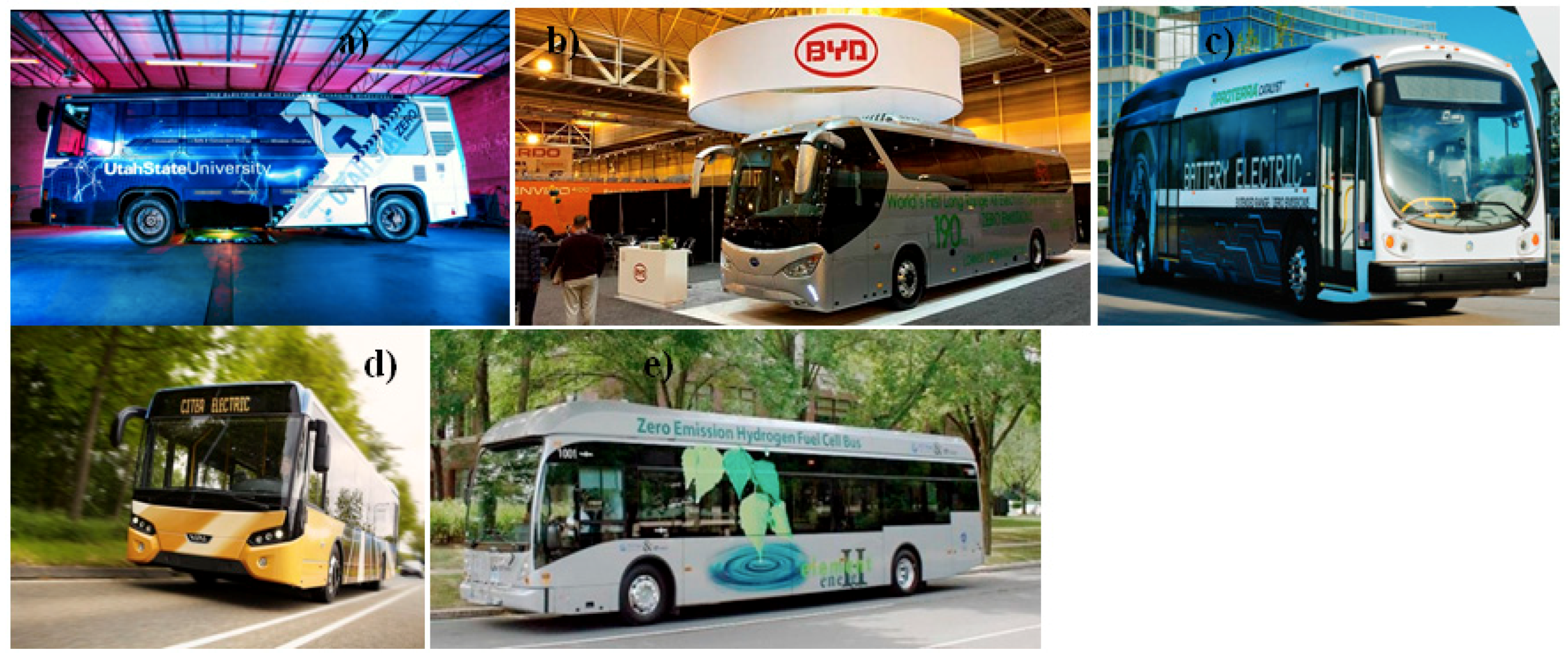
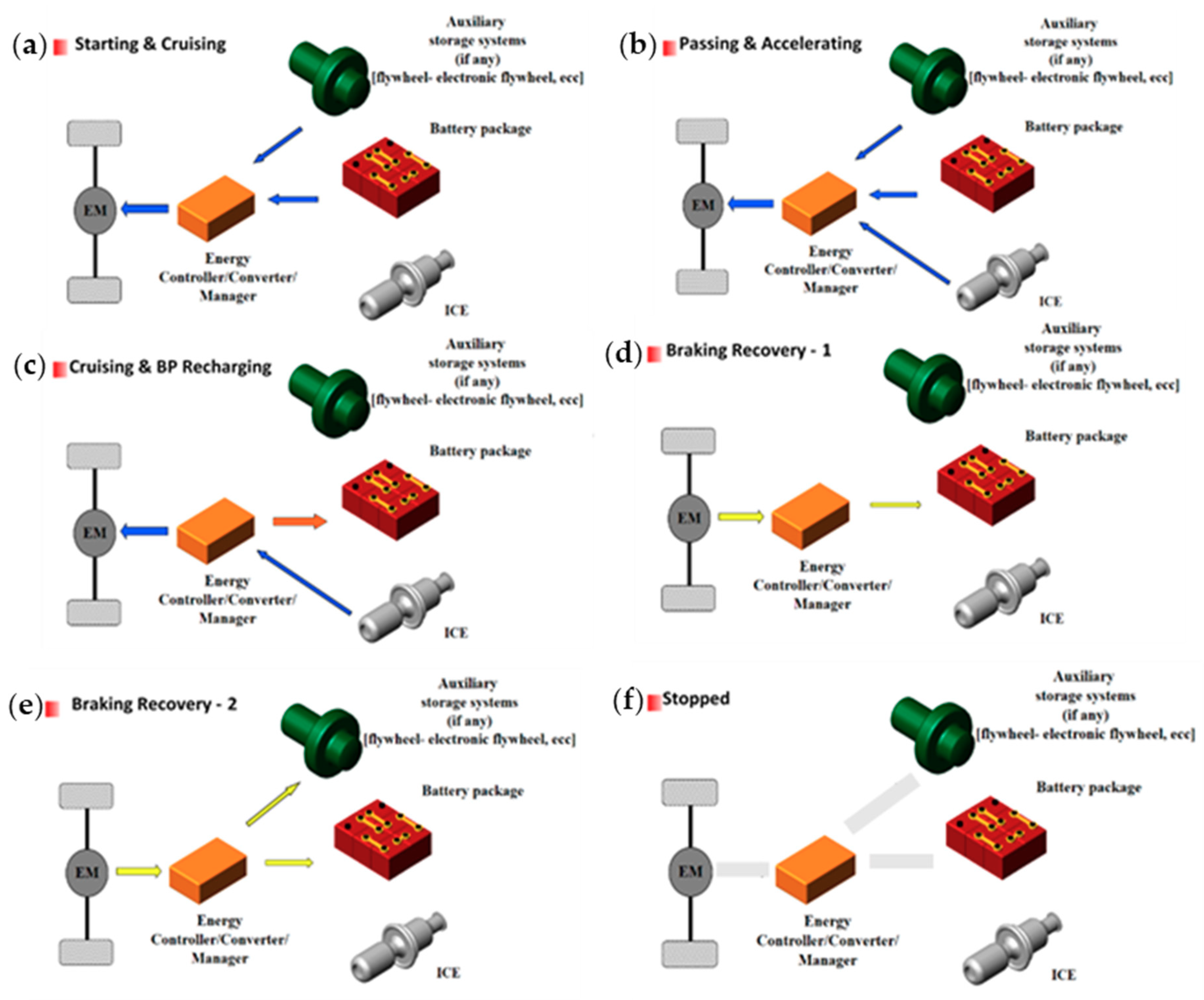
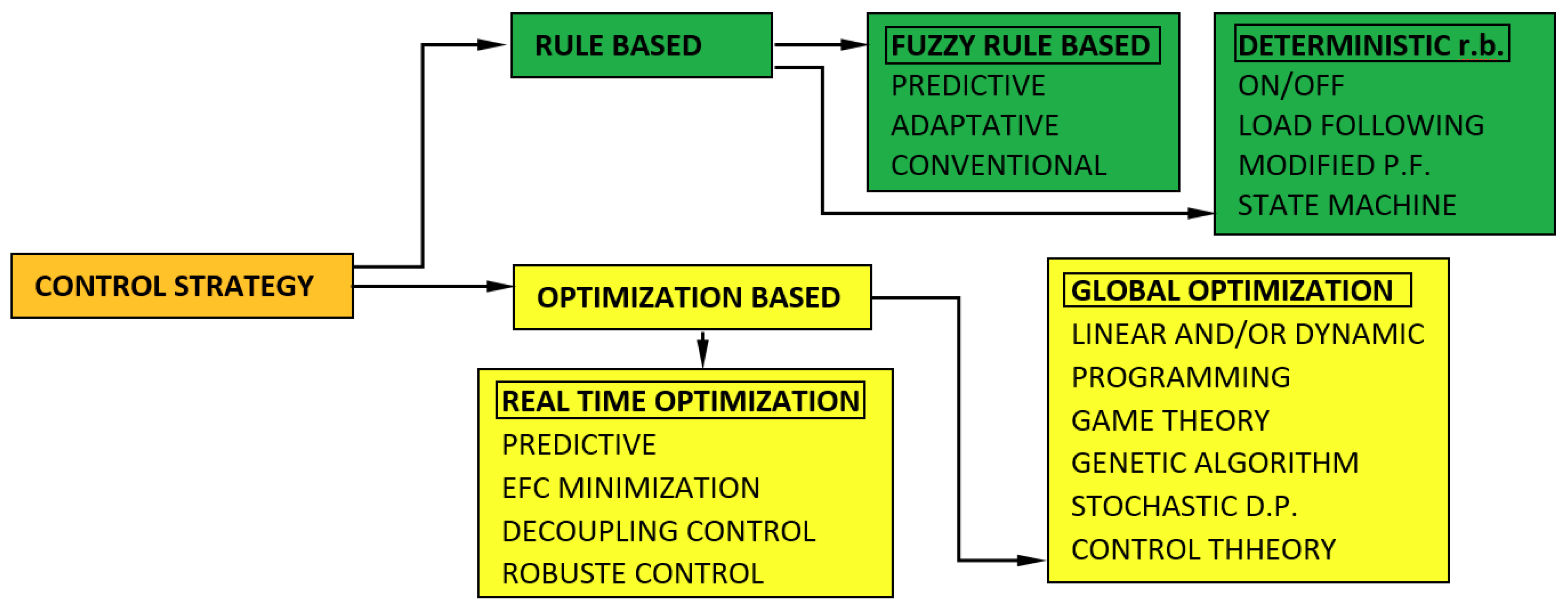
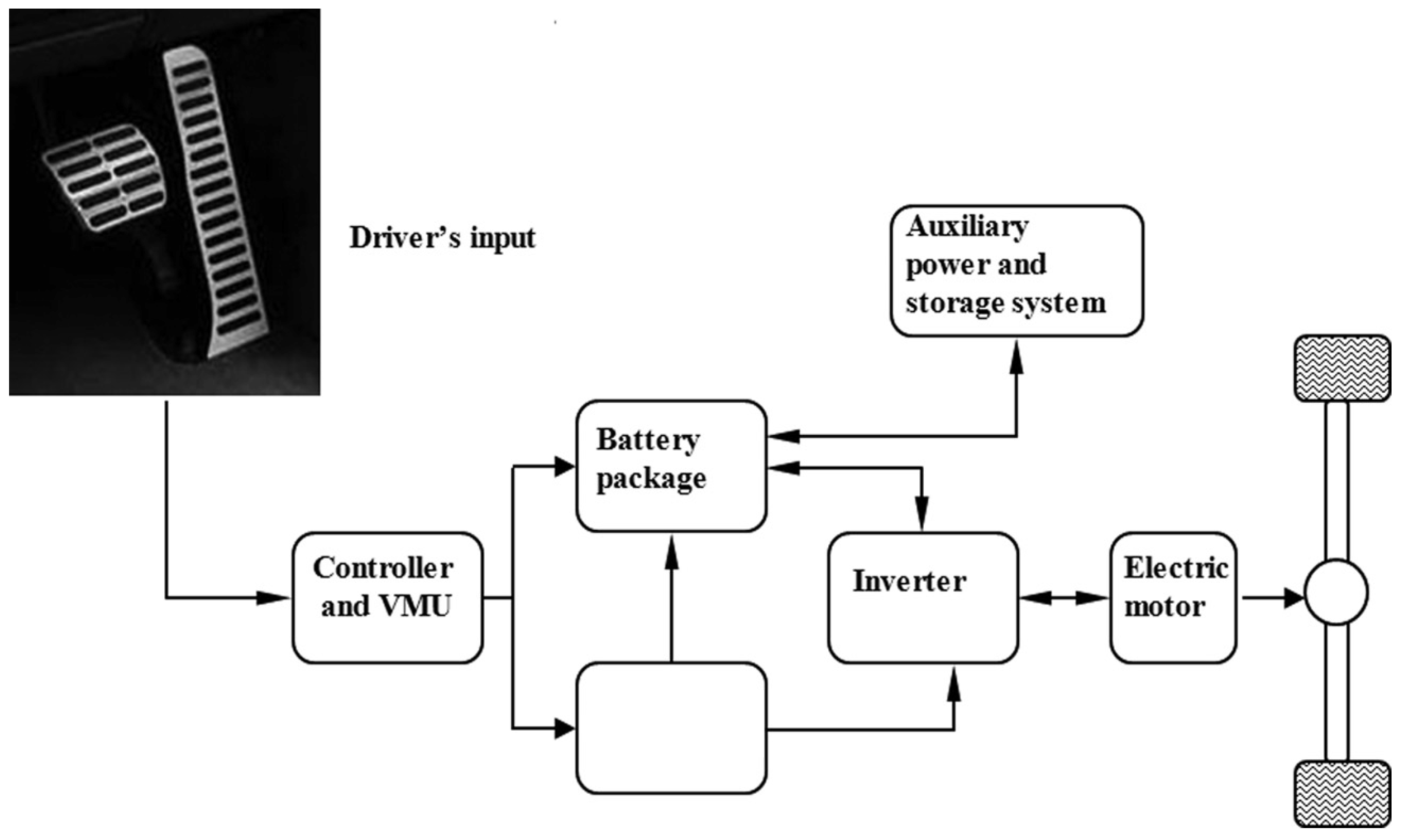
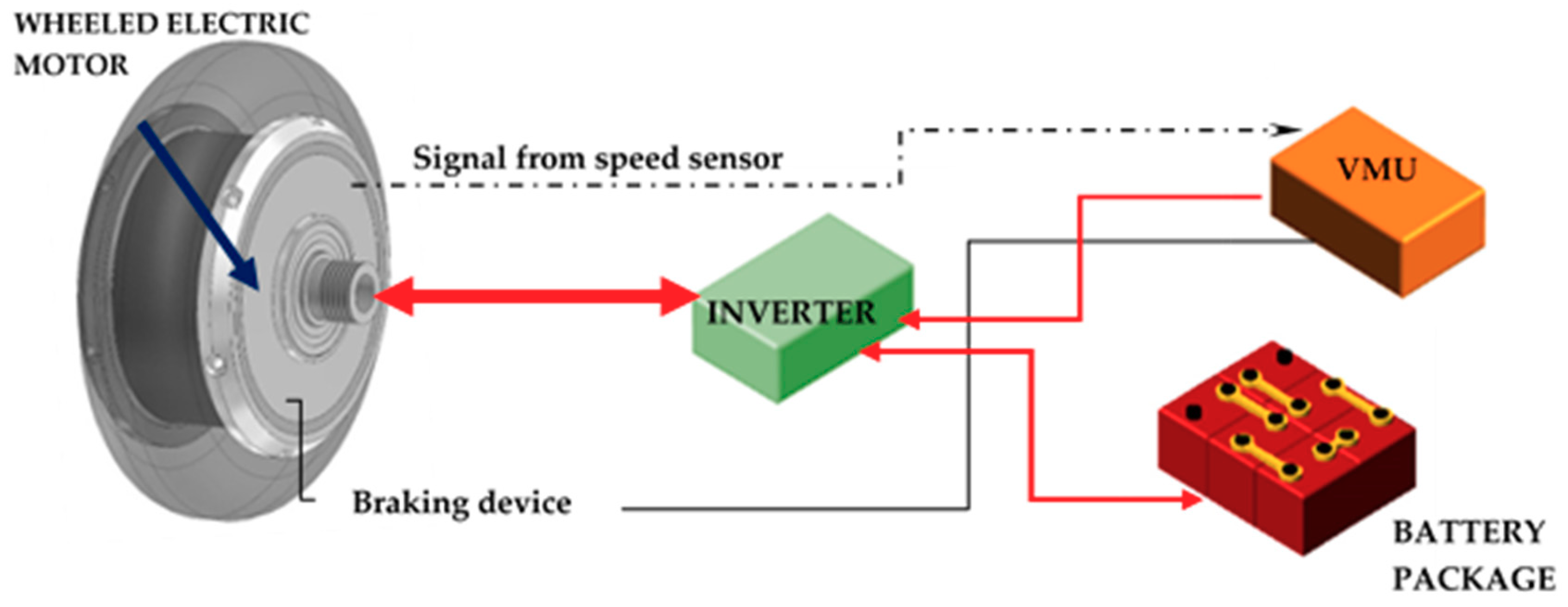
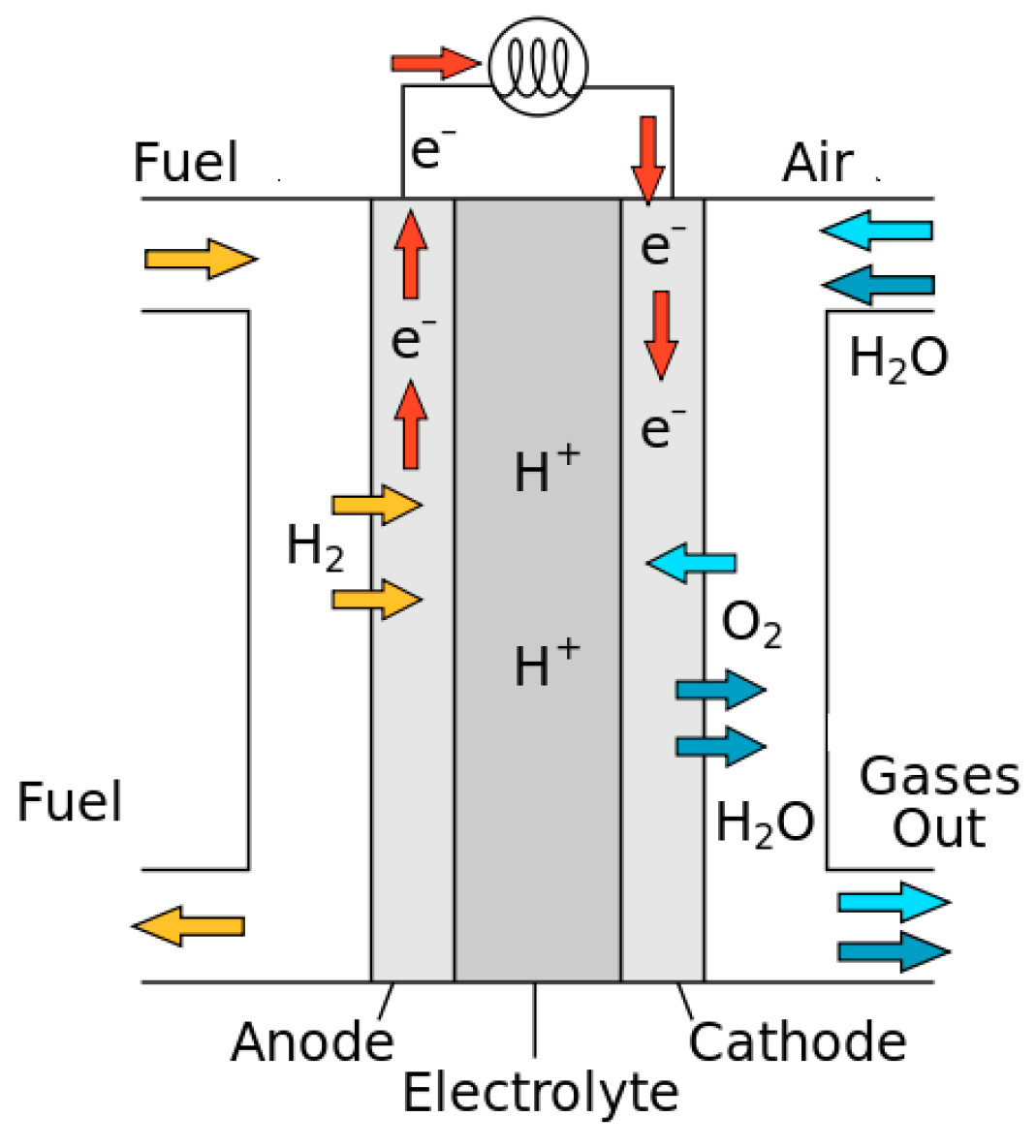
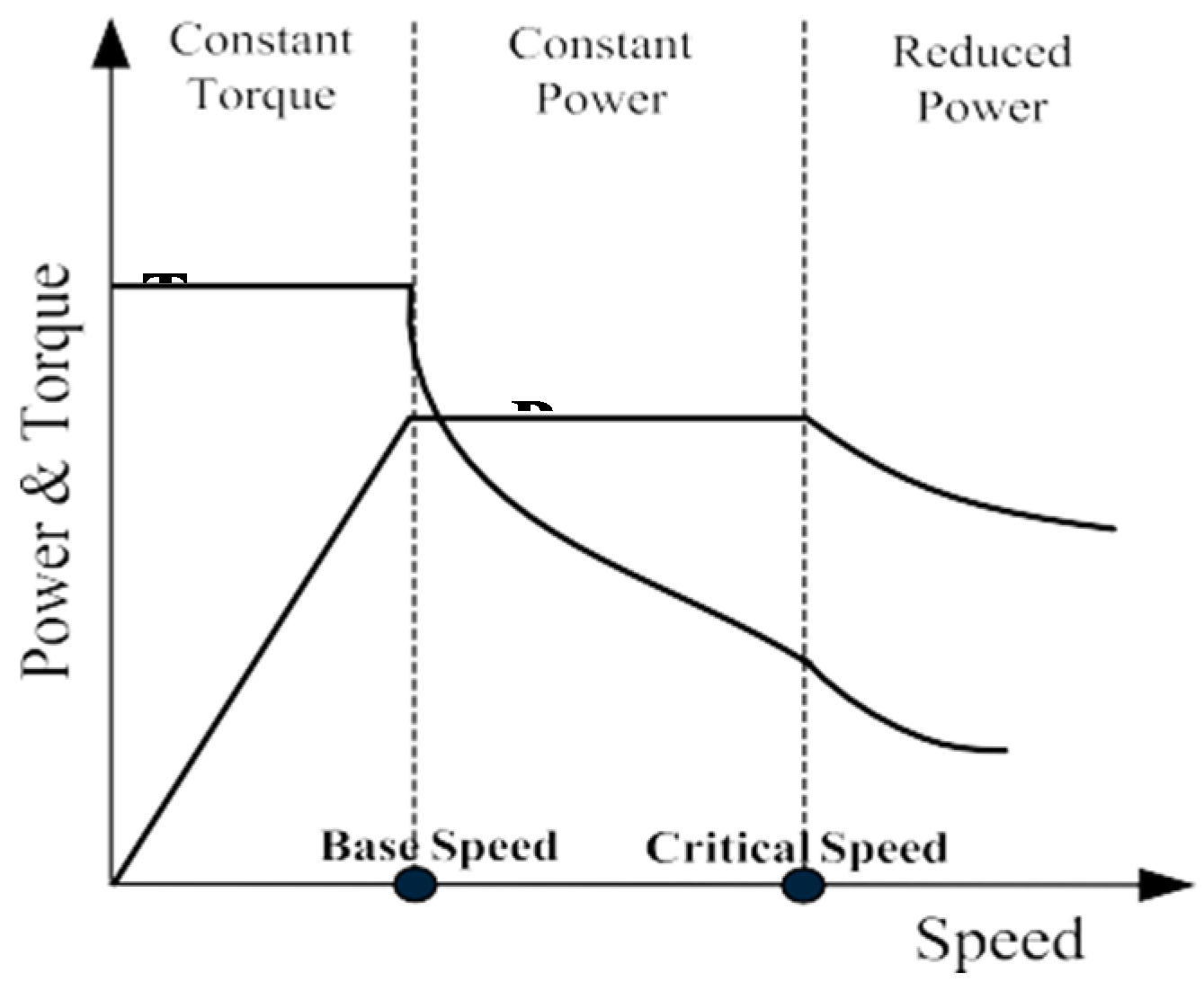
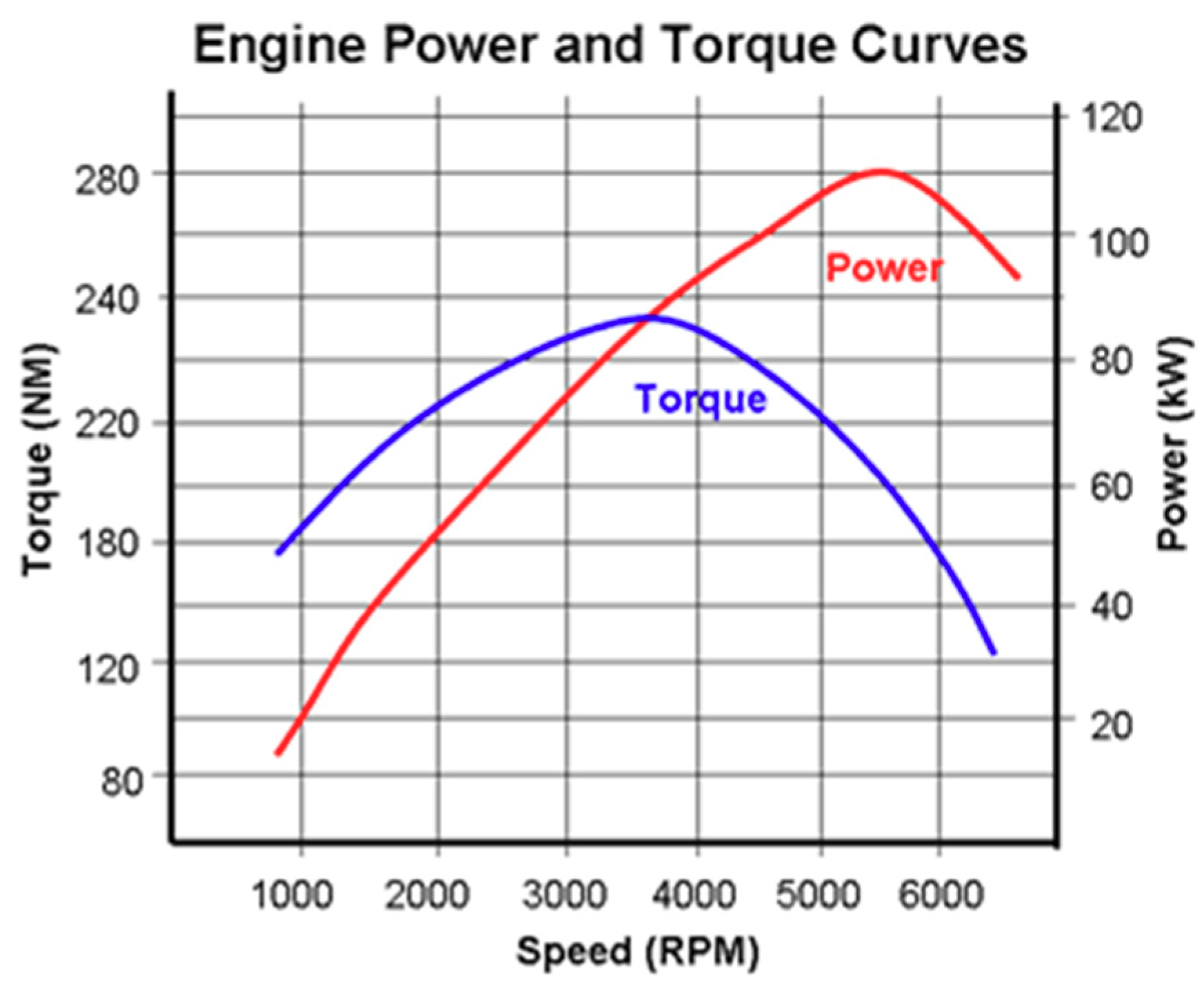
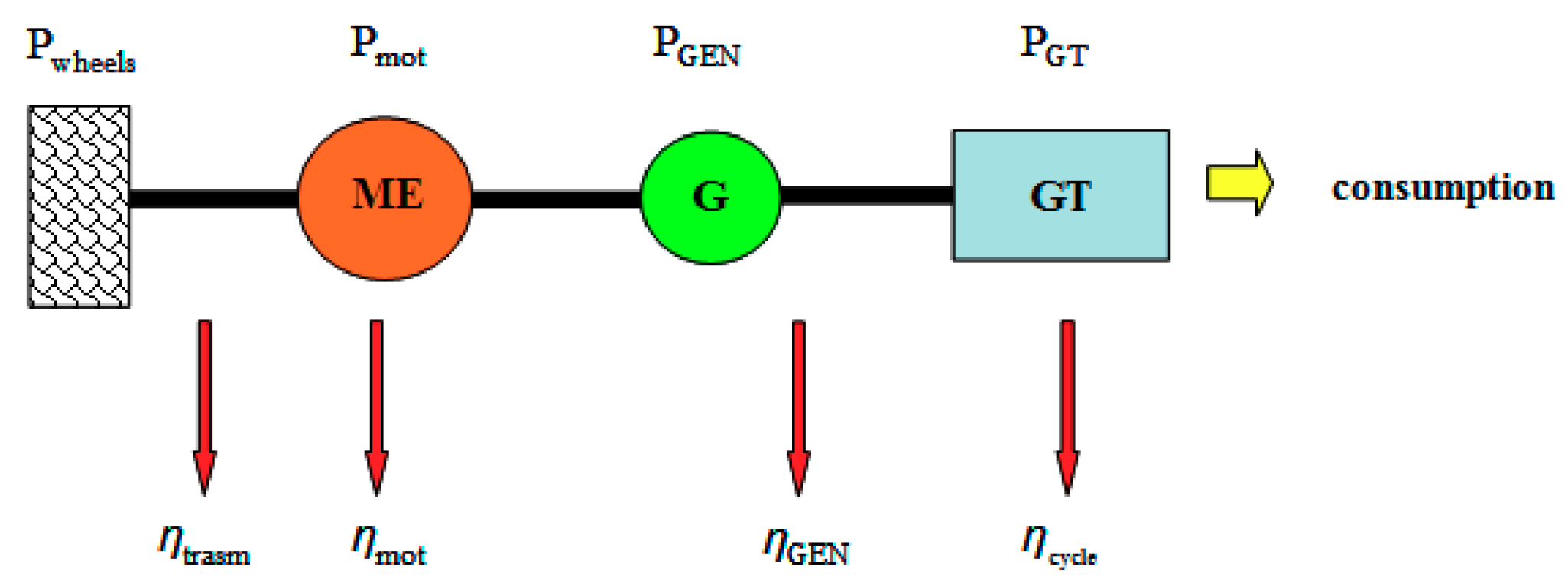
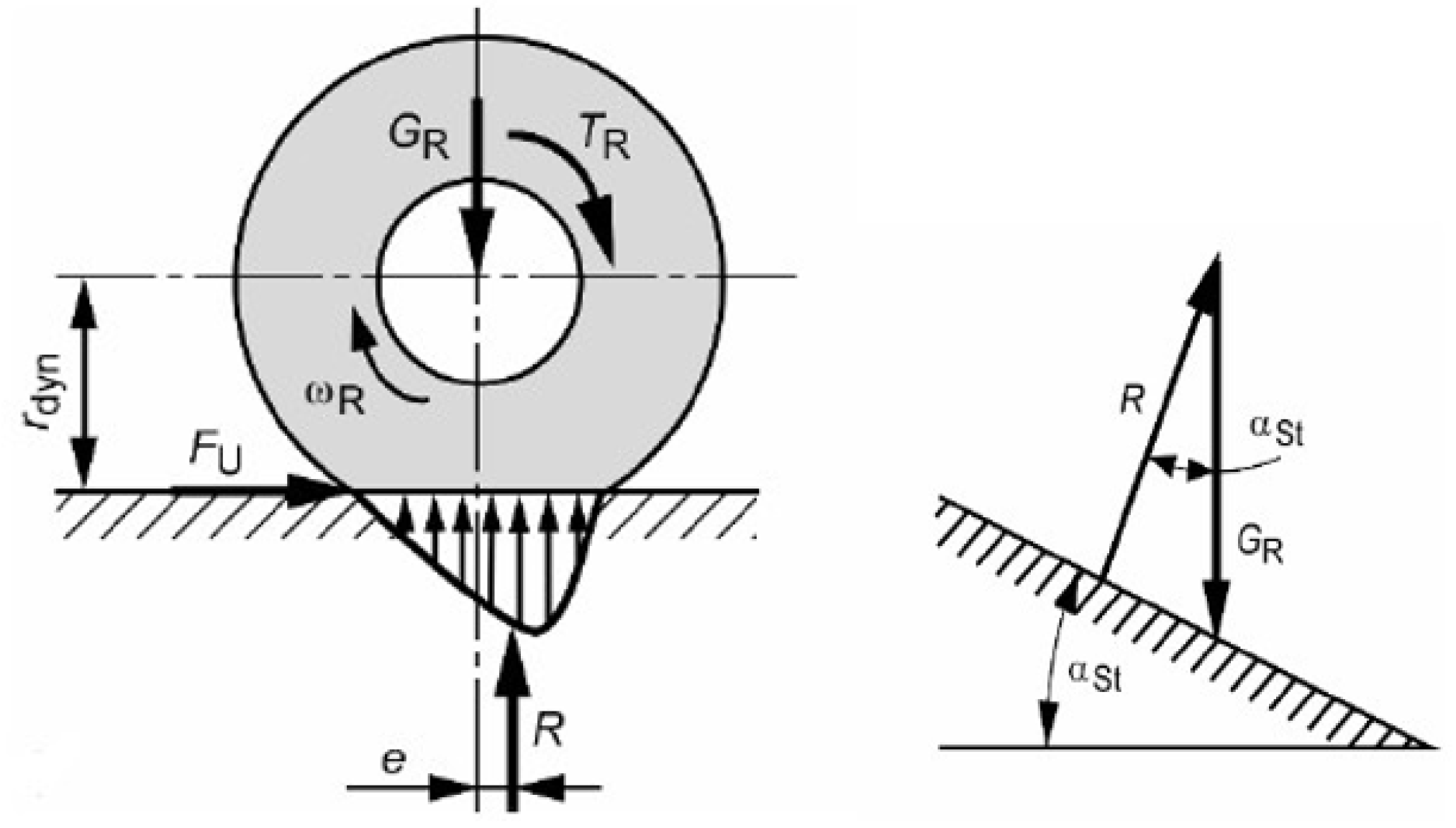
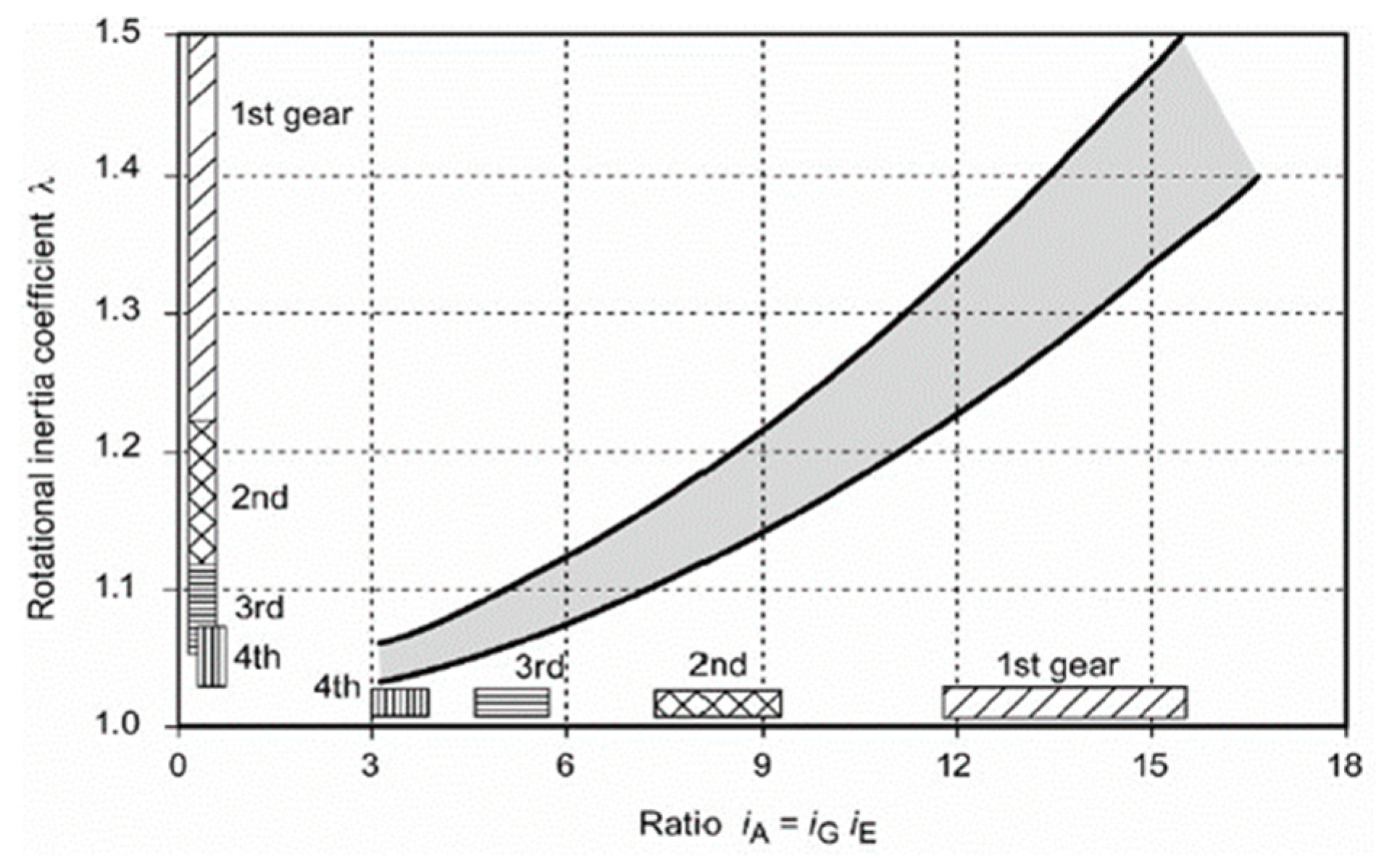
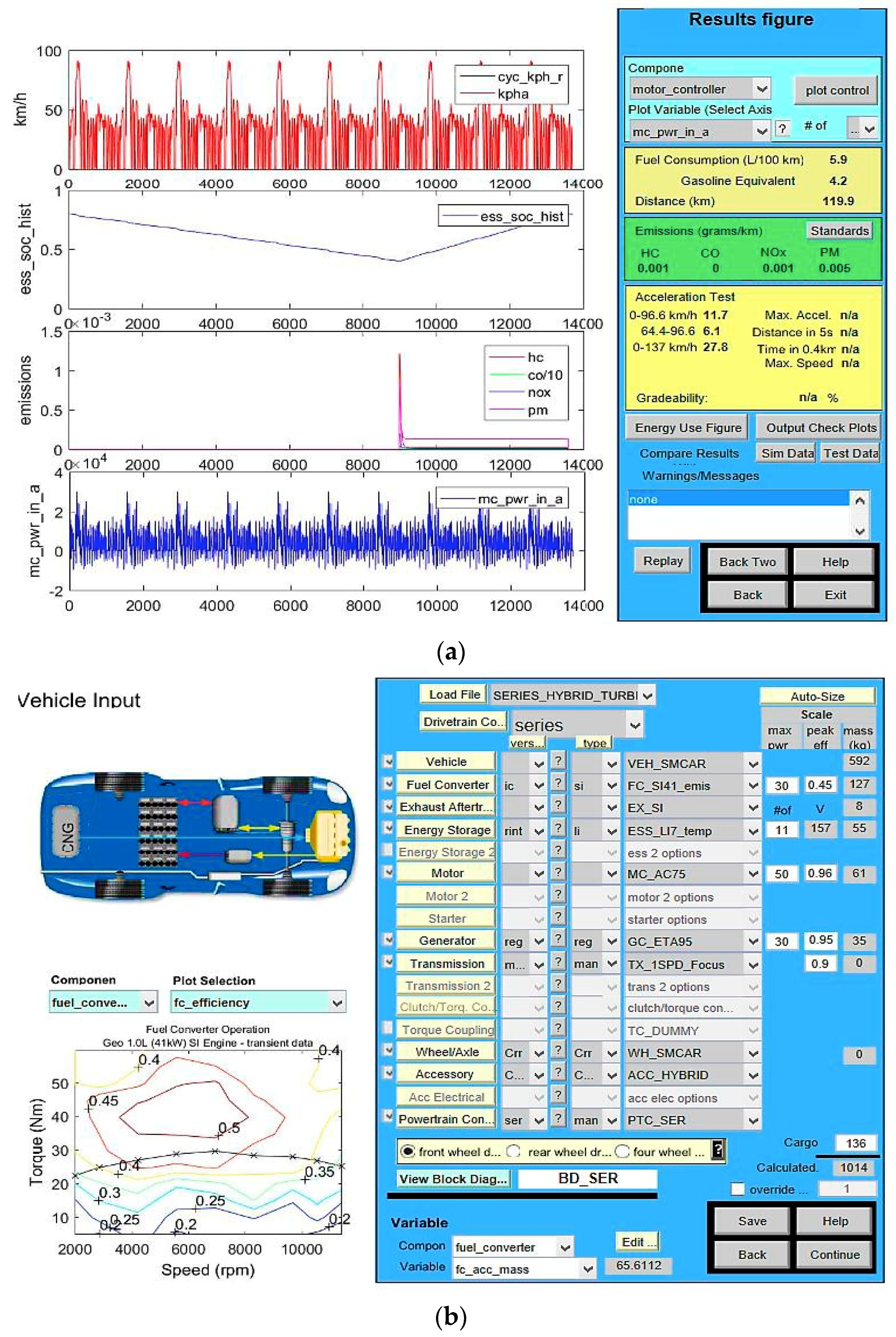
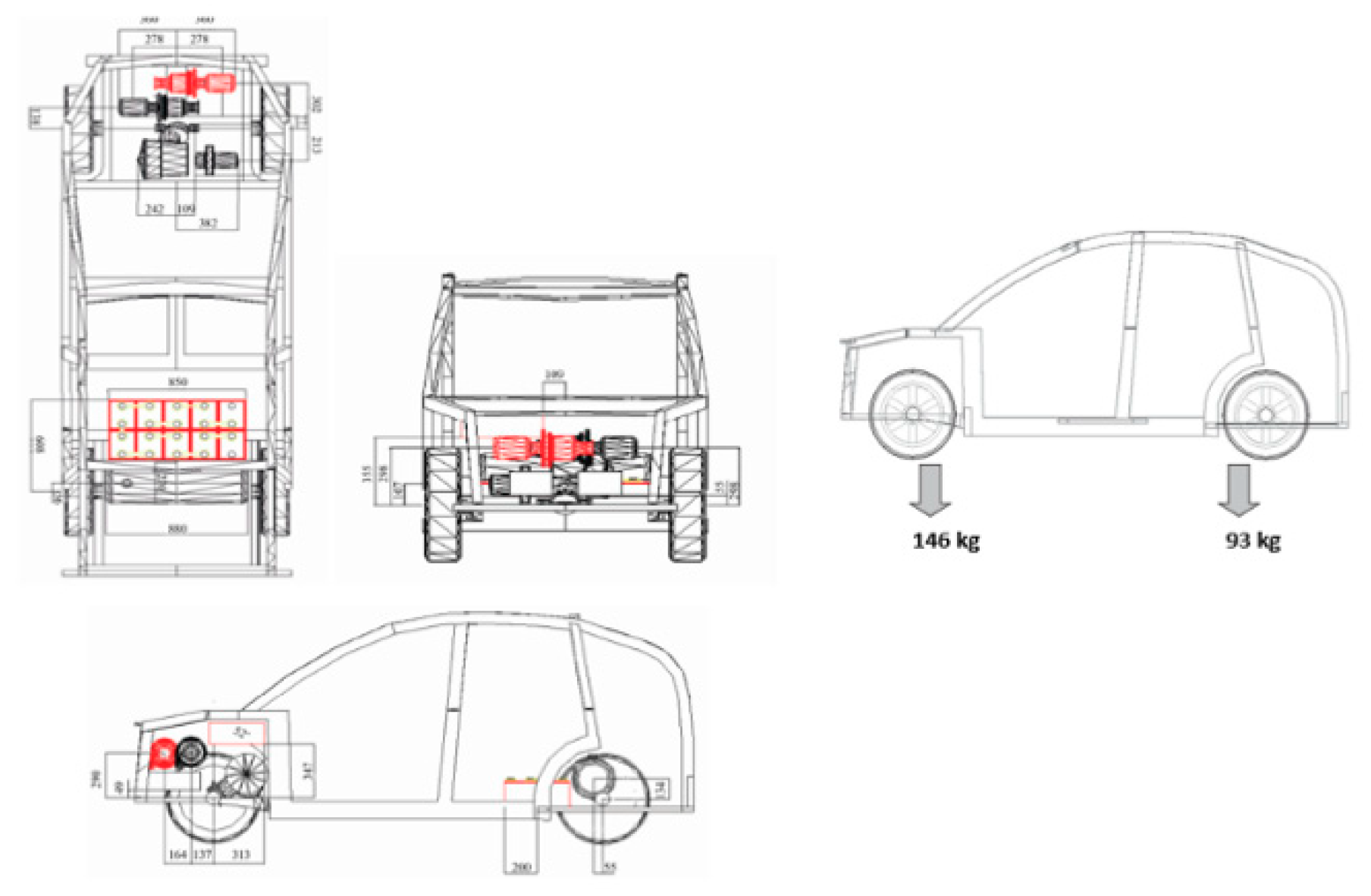
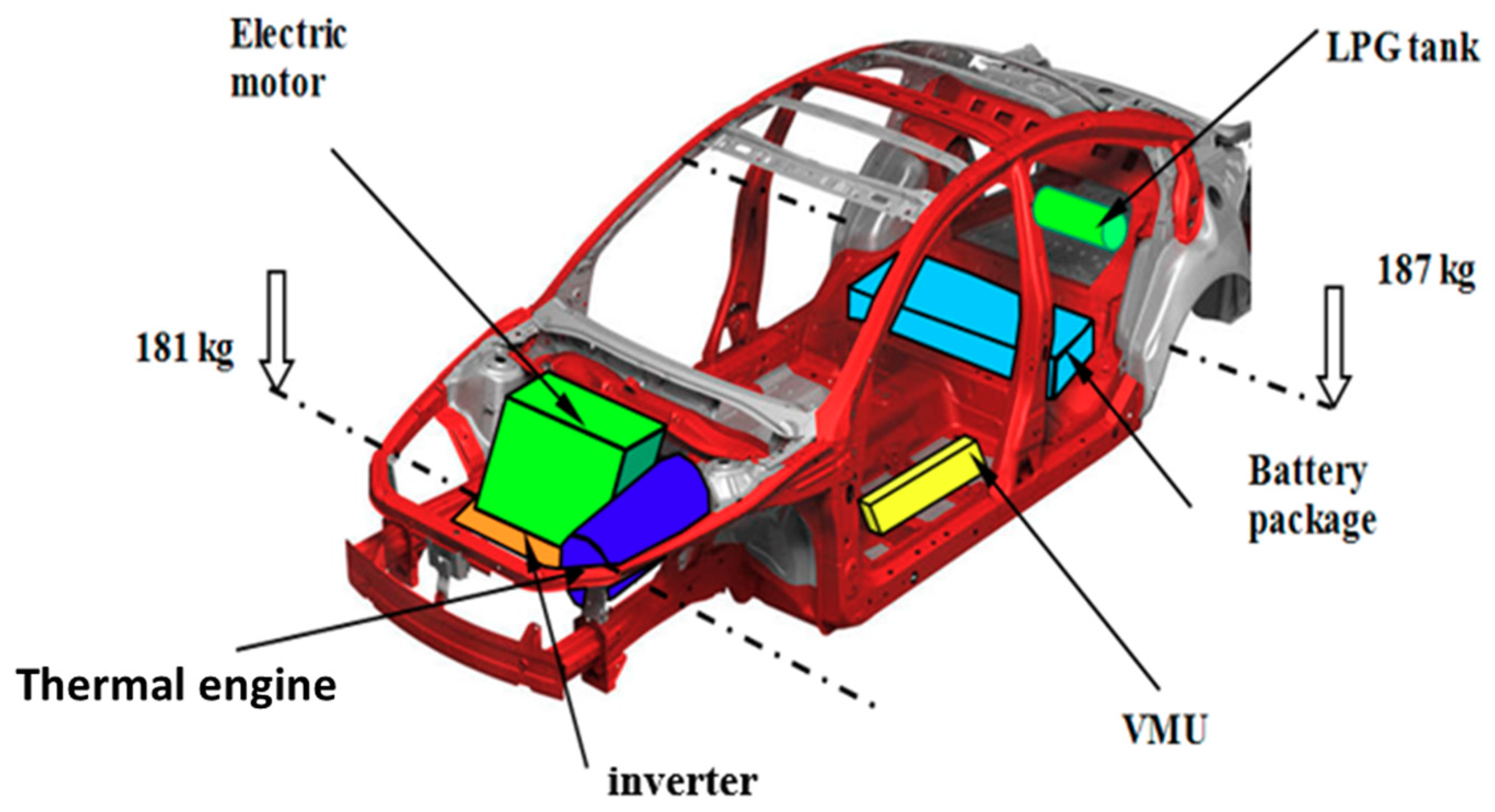
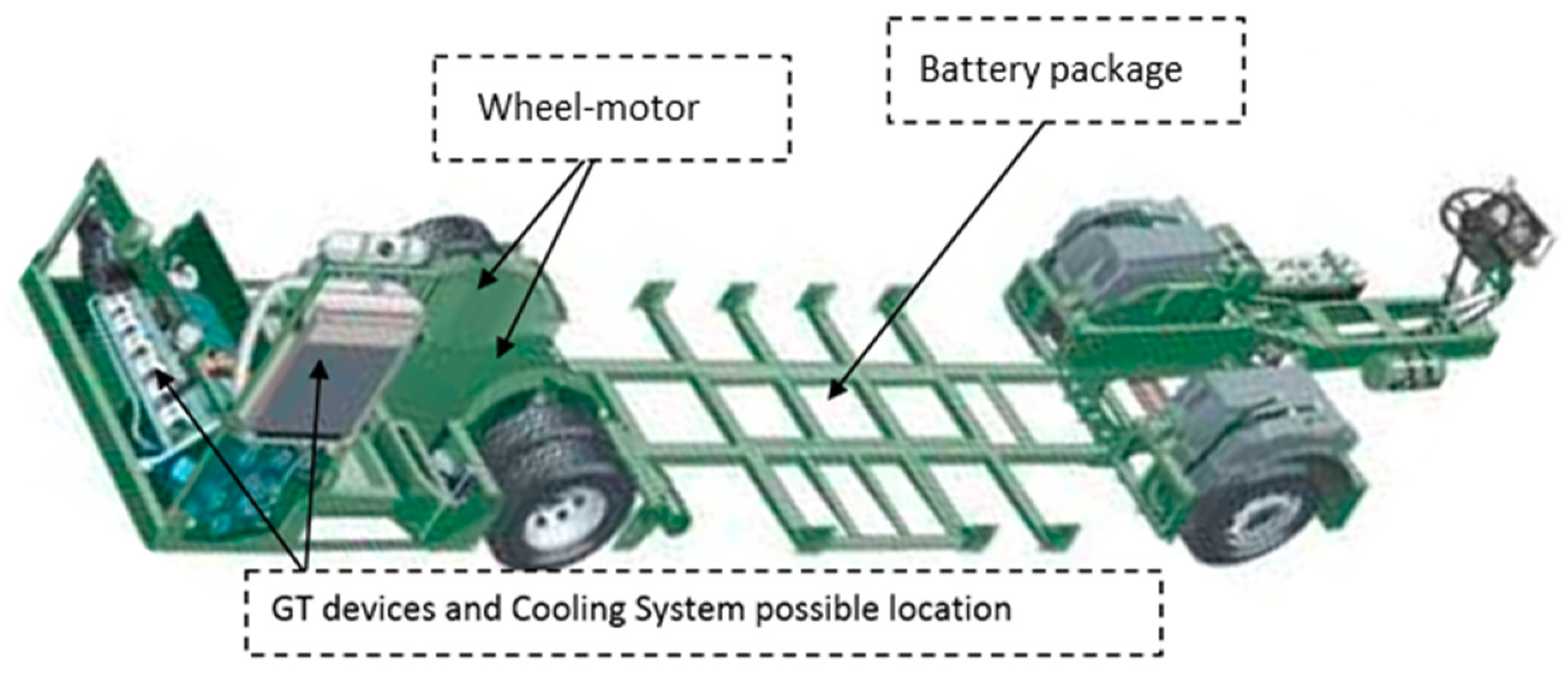
| Normative/Directive | Carbon Oxide CO | Hydrocarbons HC | Nitrogen Oxide NOx | Combined HC + NOx | Particulate Matter PM | ||||
|---|---|---|---|---|---|---|---|---|---|
| Gasoline | Diesel | Gasoline | Diesel | Gasoline | Diesel | Gasoline | Diesel | Diesel | |
| 91/441-1992 (EURO 1) | 2.72 | 2.72 | - | - | - | - | 0.97 | 0.97 | 0.14 |
| 94/12-1996 (EURO 2) | 2.20 | 1.00 | - | - | - | - | 0.50 | 0.70 | 0.08 |
| 98/69A-2000 (EURO 3) | 2.30 | 0.64 | 0.20 | - | 0.15 | 0.50 | - | 0.56 | 0.05 |
| 98/69B-2005 (EURO 4) | 1.00 | 0.50 | 0.10 | - | 0.8 | 0.25 | - | 0.30 | 0.025 |
| 715/2007-2011 (EURO 5) | 1.00 | 0.50 | 0.10 | - | 0.6 | 0.18 | - | 0.23 | 0.005 |
| 715/2007-2015 (EURO 6) | 1.00 | 0.50 | 0.10 | - | 0.6 | 08 | - | 0.17 | 0.005 |
| Systems Characteristics/Type of Vehicle | EV | HEV |
|---|---|---|
| Propulsion | Electric motors | Electric motor Thermal engine |
| Energy storage | Battery package Ultracapacitors | Battery package Ultracapacitors Fuel tank |
| Energy source infrastructure | Electric grid | Electric grid Commercial gas station |
| Characteristics | Zero emissions High efficiency Relatively short range Fuel independence High cost Commercial availability | Low emissions Relatively high fuel economy Extended range High cost Commercial availability Partial fossil fuel independence |
| Issues | Battery package overall dimensions and weight Battery MBTF Charging stationsCost | Battery package overall dimensions, weight, and management Energy fluxes control, management, and optimization |
| Features | Optimized power plant |
| Modular power plant possibilities | |
| Long operational life | |
| Excellent transient response | |
| Engine down sizing | |
| Advantageous packaging | |
| Possibility of Zero Emissions Operation Mode | |
| System complexity | |
| Drawbacks | Larger traction drive system |
| Multiple Energy conversions | |
| Optimized design of algorithms | |
| High investment cost | |
| Larger traction drive system | |
| Applications | City cars/passenger sedan/urban and extra urban bus |
| Features Drawbacks | Economic gain at high cost |
| Possibility of Zero Emissions Operation Mode | |
| System complexity | |
| Expensive system | |
| Complexity of control system | |
| Complex volume packaging | |
| Optimized design of algorithms | |
| High voltage required to improve efficiency | |
| Applications | Bus/heavy truck |
| Chemistry | Nominal Operative Voltage [V] N.O.V | Energy Density [Wh/kg] | Cycle Life | Self-Discharge Rate [%/Month] |
|---|---|---|---|---|
| Lead-Acid | 2 | 30–40 | 500–200 | 3–20 |
| Ni-Mh | 1.2 | 65–70 | 500–800 | 30 |
| Li-ion | 3.7 | 100–150 | 1000–1200 | 8 |
| LiPo | 3.7 | 130–200 | 800–1200 | 5 |
| LiFePO4 | 3.2 | 90–160 | 1500–3000 | <3 |
| LiTi | 2.3 | 70–100 | ≥4000 | <3 |
| Module Mass mmod | 19.1 kg |
| Module Voltage Vmod | 12.8 V |
| Cell Voltage Vcel | 3.2 V |
| Specific Power Psp | 201 W/kg |
| Specific Energy Esp | 67 Wh/kg |
| Battery Capacity C | 100 Ah |
| Maximum Current Cmax | 450 A |
| Charging Time [s] | 0.3–30 |
| Discharging Time [s] | 0.3–30 |
| Energy Density [Wh/kg] | 1–10 |
| Power Density [W/kg] | <10,000 |
| MTBF | >500,000 |
| Efficiency [%] | 85–97 |
| Flywheel Purpose, Type | Geometric Shape Factor [k] | Mass [kg] | Diameter [m] | Angular Velocity [rpm] | Energy Store [MJ] | Energy Stored [kWh] | Energy Density [kWh/kg] |
|---|---|---|---|---|---|---|---|
| Small battery | 0.5 | 100 | 0.6 | 20,000 | 9.8 | 2.7 | 0.027 |
| Regenerative braking (trains) | 0.5 | 3000 | 0.5 | 8000 | 33 | 9.1 | 0.003 |
| Electric power backup | 0.5 | 600 | 0.5 | 30,000 | 92 | 26 | 0.043 |
| Characteristic | PEMFC | AFC | PAFC | MCFC | SOFC |
|---|---|---|---|---|---|
| Electrolyte | Perfluorosulfonic acid | Phosphoric acid | Phosphoric acid | Molten carbonate | Solid oxide |
| Design and structure | Simple | Simple | Simpler | Complex | Complex |
| Temperature range [°C] | 50 ÷ 100 | 80 ÷ 100 | 150 ÷ 200 | 600 ÷ 700 | 700 ÷ 1000 |
| Starting up time | Lower | Low | Low | High | Higher |
| Stack size [kW] | <1 ÷ 100 | 10 ÷ 100 | 100 ÷ 400 | 300 kW ÷ 3 MW <300 MW | 1 ÷ 2 MW |
| Sensitivity | More | Low | Low | Lower | Lower |
| Efficiency [%] | 40 ÷ 60 | 50 ÷ 60 | 40 ÷ 50 | 45 ÷ 60 | 50 ÷ 65 |
| Cell-life | 2 ÷ 10 μV/h | 0 ÷ 6 μV/h | 2 ÷ 4 μV/h | 5 μV/h | 0 ÷ 8 μV/h |
| Characteristics | Battery | Ultracapacitor | Fuel Cell | Flywheel |
|---|---|---|---|---|
| Physics | Chemical | Electrostatic | Chemical | Mechanical |
| Technology | Proven | Promising | Promising | Proven |
| Energy density | High | Low | Very high | Low |
| Power density | Low | Very high | Medium | High |
| Charging time | Hours | Seconds | n.a. | Minutes |
| Discharging time | Hours | Seconds | n.a. | Minutes |
| MTBF | 3–5 years | > 10 years | 10,000–20,000 h | >20 years |
| Efficiency [%] | 75–85 | 85–95 | 40–60 | 80–90 |
| Environmental issue | Disposal | Low | Very low | Very low |
| Commutator | No Commutator | ||
|---|---|---|---|
| Self ExcitedDC Motors | Separately Excited DC Motors | Induction Motors | Synchronous Motors |
| Series | PM excited | Cage rotor | PM motors |
| Shunt | Field excited | Wound rotor | SR motors |
| Characteristics | Commutator Motors | No Commutator Motors | ||
|---|---|---|---|---|
| Induction Motor | PM Motor | SR Motor | ||
| Controllability | 5 | 5 | 4 | 3 |
| Size and weight | 3 | 4 | 4.5 | 4 |
| Robustness | 3.5 | 5 | 4 | 4.5 |
| Reliability | 3 | 5 | 4 | 4.5 |
| Power density | 3 | 4 | 5 | 3.5 |
| Efficiency | 3 | 4 | 5 | 4.5 |
| Speed range | 2.5 | 4 | 5 | 5 |
| Life time | 3.5 | 5 | 4 | 4.5 |
| Torque density | 3 | 3.5 | 5 | 4 |
| Technical maturity | 5 | 4.5 | 4 | 3.5 |
| Cost | 3.5 | 5 | 3 | 4 |
| Over load capability | 3 | 4 | 4.5 | 4 |
| Torque ripple/noise | 3.5 | 4.5 | 4 | 3 |
| Manufacturability | 3 | 5 | 3 | 4 |
| Potential for improvements | 2.5 | 3 | 4.5 | 5 |
| City CAR Specifications | |
| Rolling radius | r = 0.25 m |
| Shape coefficient | f = 0.82 |
| Actual frontal section | Sf = 1.152 m2 |
| Drag coefficient | cx = 0.27 |
| Rolling coefficient | f = 0.015 |
| Vehicle mass | m = 980 kg |
| Equivalent vehicle mass | me = 1210 kg |
| Gravity | g = 9.81 m/s2 |
| Air density | ρ = 1.180 kg/m3 |
| Minimum SOC | 0.4 |
| Maximum SOC | 0.8 |
| SEDAN CAR Specifications | |
| Rolling radius | r = 0.25 m |
| Shape coefficient | f = 0.9 |
| Actual frontal section | Sf = 2.142 m2 |
| Drag coefficient | cx = 0.25 |
| Rolling coefficient | f = 0.015 |
| Vehicle mass | m = 1200 kg |
| Equivalent vehicle mass | me = 1240 kg |
| Gravity | g = 9.81 m/s2 |
| Air density | ρ = 1.180 kg/m3 |
| Minimum SOC | 0.6 (safety 0.4) |
| Maximum SOC | 0.8 |
| BUS Specifications | |
| Rolling radius | r = 0.46 m |
| Shape coefficient | f = 0.87 |
| Actual frontal section | Sf = 6.9 m2 |
| Drag coefficient | cx = 0.6 |
| Rolling coefficient | f = 0.018 |
| Vehicle mass | m = 7500 kg |
| Equivalent vehicle mass | me = 13300 kg |
| Gravity | g = 9.81 m/s2 |
| Air density | ρ = 1.180 kg/m3 |
| Minimum SOC | 0.42 |
| Maximum SOC | 0.8 |
© 2018 by the author. Licensee MDPI, Basel, Switzerland. This article is an open access article distributed under the terms and conditions of the Creative Commons Attribution (CC BY) license (http://creativecommons.org/licenses/by/4.0/).
Share and Cite
Capata, R. Urban and Extra-Urban Hybrid Vehicles: A Technological Review. Energies 2018, 11, 2924. https://doi.org/10.3390/en11112924
Capata R. Urban and Extra-Urban Hybrid Vehicles: A Technological Review. Energies. 2018; 11(11):2924. https://doi.org/10.3390/en11112924
Chicago/Turabian StyleCapata, Roberto. 2018. "Urban and Extra-Urban Hybrid Vehicles: A Technological Review" Energies 11, no. 11: 2924. https://doi.org/10.3390/en11112924
APA StyleCapata, R. (2018). Urban and Extra-Urban Hybrid Vehicles: A Technological Review. Energies, 11(11), 2924. https://doi.org/10.3390/en11112924





